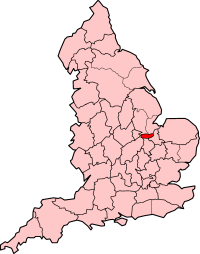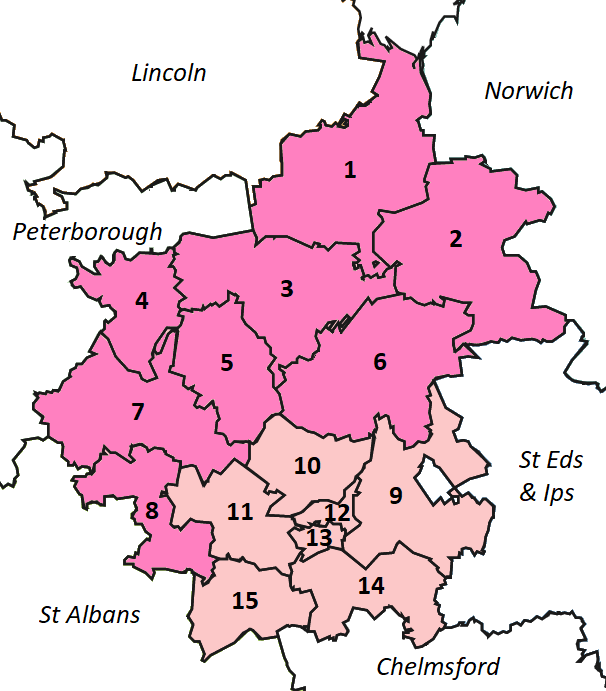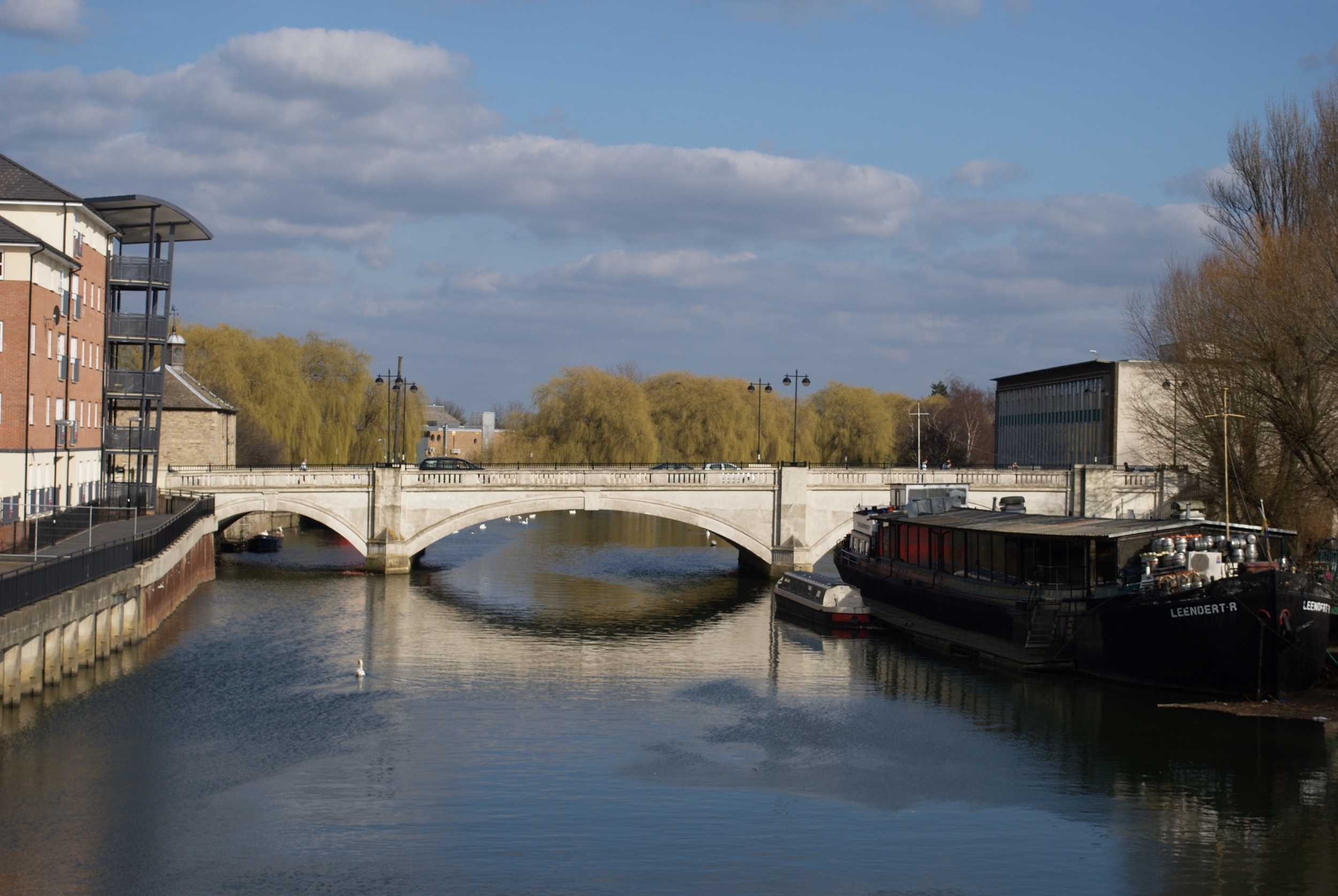|
Soke Of Peterborough
The Soke of Peterborough is a historic area of England associated with the City and Diocese of Peterborough, but considered part of Northamptonshire. The Soke was also described as the Liberty of Peterborough, or Nassaburgh hundred, and comprised, besides Peterborough, about thirty parishes. The area forms much of the present City of Peterborough unitary authority area in the post-1974 ceremonial county of Cambridgeshire. The Church of England dioceses of Peterborough and Ely still, however, follow the boundary of the Soke, with only the part of the city that is north of the River Nene lying within the Diocese of Peterborough, while Thorney and urban areas south of the Nene, including Stanground and Fletton, are in the Diocese of Ely. The term soke refers to a general legal term in medieval England referring to various concepts, including a jurisdiction of land or rights to hold a court or receive fines. History In the Saxon period, the lord of the hundred had the power, ... [...More Info...] [...Related Items...] OR: [Wikipedia] [Google] [Baidu] |
Peterborough
Peterborough () is a cathedral city in Cambridgeshire, east of England. It is the largest part of the City of Peterborough unitary authority district (which covers a larger area than Peterborough itself). It was part of Northamptonshire until 1974, when county boundary change meant the city became part of Cambridgeshire instead. The city is north of London, on the River Nene which flows into the North Sea to the north-east. In 2020 the built-up area subdivision had an estimated population of 179,349. In 2021 the Unitary Authority area had a population of 215,671. The local topography is flat, and in some places, the land lies below sea level, for example in parts of the Fens to the east and to the south of Peterborough. Human settlement in the area began before the Bronze Age, as can be seen at the Flag Fen archaeological site to the east of the current city centre, also with evidence of Roman occupation. The Anglo-Saxon period saw the establishment of a monastery, Medeshams ... [...More Info...] [...Related Items...] OR: [Wikipedia] [Google] [Baidu] |
Diocese Of Ely
The Diocese of Ely is a Church of England diocese in the Province of Canterbury. It is headed by the Bishop of Ely, who sits at Ely Cathedral in Ely. There is one suffragan (subordinate) bishop, the Bishop of Huntingdon. The diocese now covers the modern ceremonial county of Cambridgeshire (excluding the Soke of Peterborough) and western Norfolk. The diocese was created in 1109 out of part of the Diocese of Lincoln. The diocese is ancient, and the area of Ely was part of the patrimony of Saint Etheldreda. A religious house was founded in the city in 673. After her death in 679 she was buried outside the church, and her remains were later reburied inside, the foundress being commemorated as a great Anglian saint. The diocese has had its boundaries altered various times. From an original diocese covering the historic county of Cambridgeshire and the Isle of Ely, Bedfordshire and Huntingdonshire were added in 1837 from the Diocese of Lincoln, as was the Sudbury archdeaconry ... [...More Info...] [...Related Items...] OR: [Wikipedia] [Google] [Baidu] |
Peterborough Cathedral Exterior 2, Cambridgeshire, UK - Diliff
Peterborough () is a cathedral city in Cambridgeshire, east of England. It is the largest part of the City of Peterborough unitary authority district (which covers a larger area than Peterborough itself). It was part of Northamptonshire until 1974, when county boundary change meant the city became part of Cambridgeshire instead. The city is north of London, on the River Nene which flows into the North Sea to the north-east. In 2020 the built-up area subdivision had an estimated population of 179,349. In 2021 the Unitary Authority area had a population of 215,671. The local topography is flat, and in some places, the land lies below sea level, for example in parts of the Fens to the east and to the south of Peterborough. Human settlement in the area began before the Bronze Age, as can be seen at the Flag Fen archaeological site to the east of the current city centre, also with evidence of Roman occupation. The Anglo-Saxon period saw the establishment of a monastery, Medeshamst ... [...More Info...] [...Related Items...] OR: [Wikipedia] [Google] [Baidu] |
Petty Sessions
Courts of petty session, established from around the 1730s, were local courts consisting of magistrates, held for each petty sessional division (usually based on the county divisions known as hundreds) in England, Wales, and Ireland. The session's work dealt with matters such as minor theft and larceny, assault, drunkenness, bastardy examinations, arbitration and deciding whether to refer a case to the quarter sessions. From 1872 the courts of petty sessions were also responsible for approving licences to sell alcohol in alehouses and public houses. They were also later established in British colonies, including Australia. They were abolished in New South Wales on 31 December 1984. Following the abolition of the courts of quarter sessions, which were also presided over by magistrates, the courts of petty sessions gradually became synonymous with "magistrates' courts", a term which had previously been used to refer to both the petty and quarter sessions. Magistrates' courts conti ... [...More Info...] [...Related Items...] OR: [Wikipedia] [Google] [Baidu] |
Northampton
Northampton () is a market town and civil parish in the East Midlands of England, on the River Nene, north-west of London and south-east of Birmingham. The county town of Northamptonshire, Northampton is one of the largest towns in England; it had a population of 212,100 in its previous local authority in the United Kingdom Census 2011, 2011 census (225,100 as of 2018 estimates). In its urban area, which includes Boughton, Northamptonshire, Boughton and Moulton, Northamptonshire, Moulton, it had a population of 215,963 as of 2011. Archaeological evidence of settlement in the area dates to the Bronze Age Britain, Bronze Age, Roman conquest of Britain, Romans and Anglo-Saxons, Anglo-Saxons. In the Middle Ages, the town rose to national significance with the establishment of Northampton Castle, an occasional royal residence which regularly hosted the Parliament of England. Medieval Northampton had many churches, monasteries and the University of Northampton (thirteenth century), ... [...More Info...] [...Related Items...] OR: [Wikipedia] [Google] [Baidu] |
Quarter Sessions
The courts of quarter sessions or quarter sessions were local courts traditionally held at four set times each year in the Kingdom of England from 1388 (extending also to Wales following the Laws in Wales Act 1535). They were also established in Scotland, Ireland and in various other dominions of the British Empire. Quarter sessions generally sat in the seat of each county and county borough, and in numerous non-county boroughs (mainly, but not exclusively, ancient boroughs), which were entitled to hold their own quarter sessions''Whitaker's Almanack'' 1968, pp 465-6. (see below), although some of the smaller boroughs lost their own quarter sessions in 1951 (see below). All quarter sessions were abolished in England and Wales in 1972, when the Courts Act 1971 replaced them and the assizes with a single permanent Crown Court. In Scotland, they survived until 1975, when they were abolished and replaced by district courts and later by justice of the peace courts. The quarter ses ... [...More Info...] [...Related Items...] OR: [Wikipedia] [Google] [Baidu] |
Socage
Socage () was one of the feudal duties and land tenure forms in the Feudalism, English feudal system. It eventually evolved into the freehold tenure called "free and common socage", which did not involve feudal duties. Farmers held land in exchange for clearly defined, fixed payments made at specified intervals to feudal lords. The lord was therefore obligated to provide certain services, such as protection, to the farmer and other duties to the Crown. Payments usually took the form of cash, but occasionally could be made with goods. Socage contrasted with other forms of tenure, including serjeanty, frankalmoin and knight-service. The England and Wales, English statute ''Quia Emptores'' of Edward I of England, Edward I (1290) established that socage tenure passed from one generation or nominee to the next would be subject to inquisitions post mortem, which would usually involve a feudal relief tax. This contrasts with the treatment of Leasehold estate, leases, which could be lif ... [...More Info...] [...Related Items...] OR: [Wikipedia] [Google] [Baidu] |
Abbots
Abbot is an ecclesiastical title given to the male head of a monastery in various Western religious traditions, including Christianity. The office may also be given as an honorary title to a clergyman who is not the head of a monastery. The female equivalent is abbess. Origins The title had its origin in the monasteries of Egypt and Syria, spread through the eastern Mediterranean, and soon became accepted generally in all languages as the designation of the head of a monastery. The word is derived from the Aramaic ' meaning "father" or ', meaning "my father" (it still has this meaning in contemporary Hebrew: אבא and Aramaic: ܐܒܐ) In the Septuagint, it was written as "abbas". At first it was employed as a respectful title for any monk, but it was soon restricted by canon law to certain priestly superiors. At times it was applied to various priests, e.g. at the court of the Frankish monarchy the ' ("of the palace"') and ' ("of the camp") were chaplains to the Merovingian and ... [...More Info...] [...Related Items...] OR: [Wikipedia] [Google] [Baidu] |
Hundred (county Division)
A hundred is an administrative division that is geographically part of a larger region. It was formerly used in England, Wales, some parts of the United States, Denmark, Southern Schleswig, Sweden, Finland, Norway, the Bishopric of Ösel–Wiek, Curonia, the Ukrainian state of the Cossack Hetmanate and in Cumberland County in the British Colony of New South Wales. It is still used in other places, including in Australia (in South Australia and the Northern Territory). Other terms for the hundred in English and other languages include ''wapentake'', ''herred'' (Danish and Bokmål Norwegian), ''herad'' ( Nynorsk Norwegian), ''hérað'' (Icelandic), ''härad'' or ''hundare'' (Swedish), ''Harde'' (German), ''hiird'' ( North Frisian), ''satakunta'' or ''kihlakunta'' (Finnish), ''kihelkond'' (Estonian), ''kiligunda'' (Livonian), '' cantref'' (Welsh) and ''sotnia'' (Slavic). In Ireland, a similar subdivision of counties is referred to as a barony, and a hundred is a subdivision of a pa ... [...More Info...] [...Related Items...] OR: [Wikipedia] [Google] [Baidu] |
Anglo-Saxons
The Anglo-Saxons were a Cultural identity, cultural group who inhabited England in the Early Middle Ages. They traced their origins to settlers who came to Britain from mainland Europe in the 5th century. However, the ethnogenesis of the Anglo-Saxons happened within Britain, and the identity was not merely imported. Anglo-Saxon identity arose from interaction between incoming groups from several Germanic peoples, Germanic tribes, both amongst themselves, and with Celtic Britons, indigenous Britons. Many of the natives, over time, adopted Anglo-Saxon culture and language and were assimilated. The Anglo-Saxons established the concept, and the Kingdom of England, Kingdom, of England, and though the modern English language owes somewhat less than 26% of its words to their language, this includes the vast majority of words used in everyday speech. Historically, the Anglo-Saxon period denotes the period in Britain between about 450 and 1066, after Anglo-Saxon settlement of Britain, th ... [...More Info...] [...Related Items...] OR: [Wikipedia] [Google] [Baidu] |
Medieval England
England in the Middle Ages concerns the history of England during the medieval period, from the end of the 5th century through to the start of the Early Modern period in 1485. When England emerged from the collapse of the Roman Empire, the economy was in tatters and many of the towns abandoned. After several centuries of Germanic immigration, new identities and cultures began to emerge, developing into kingdoms that competed for power. A rich artistic culture flourished under the Anglo-Saxons, producing epic poems such as ''Beowulf'' and sophisticated metalwork. The Anglo-Saxons converted to Christianity in the 7th century and a network of monasteries and convents were built across England. In the 8th and 9th centuries England faced fierce Viking attacks, and the fighting lasted for many decades, eventually establishing Wessex as the most powerful kingdom and promoting the growth of an English identity. Despite repeated crises of succession and a Danish seizure of power at the ... [...More Info...] [...Related Items...] OR: [Wikipedia] [Google] [Baidu] |
Fletton
Fletton is an area of the city of Peterborough, in the Peterborough district, in the ceremonial county of Cambridgeshire, England, south of the River Nene. Notable for its large brickworks, the area has given its name to "Fletton bricks", Administration Lying south of the River Nene, the area was historically part of Huntingdonshire (although not the present district of that name), rather than the Soke of Peterborough in Northamptonshire. It was divided into Old Fletton, which prior to the Local Government Act 1972 formed a separate town with its own council (Old Fletton Urban District) and New Fletton which, from 1874, was administered as part of Peterborough Municipal Borough. Some maps still show New Fletton (on the south bank of the river) as well as Old Fletton (further to the south) with the boundary at Fletton Spring. In 1965, the administrative counties of Huntingdonshire and the Soke of Peterborough amalgamated as Huntingdon and Peterborough and, in 1974, Fletton became ... [...More Info...] [...Related Items...] OR: [Wikipedia] [Google] [Baidu] |






.jpg)


